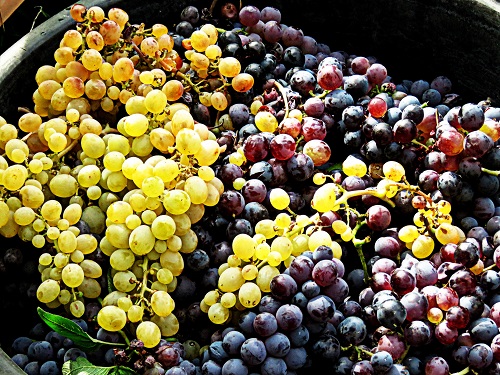Grape harvest is a tradition of many Countries in the world. It is a celebration of joy in the community for many cultures. On Mount Etna, grape harvest is a celebration that mixes pagan rituals with the tradition of the sacred land of the volcano. Still today, the collection of grapes is a strong, impressive event to live. And it will give emotions to tourists visiting for the first time.
On Mt Etna there are different times for harvest, though it usually takes place between 15th and 30th September. Sometimes you will collect grapes in October too, or even in late August – but working at night, in that case. If it rains or is windy, only a few skilled people will collect the grapes. But the final dinner is open to everyone.
Mt Etna’s grapes
Mt. Etna’s grapes are among the juiciest and the best in Italy. They grow by feeding on the rich volcanic soil and develop thanks to a climate that gives abundant rains and equally numerous sunny days. The combination of the two things means that the plant gives its fruits on time and always in abundance. The grapes that grow favored by the volcanic soil are: Nerello Mascalese, Nerello Cappuccio, Carricante, Catarratto.
 mt etna’s grapes
mt etna’s grapes
The first two are red wines, the other two are white. The vineyard areas around the volcano are mainly on the eastern and northern flanks. The territories between Pedara, Zafferana Etnea, Mascali, Linguaglossa, Solicchiata and Randazzo, to be precise, are the realm of good wine. The harvests, in these areas, are a tradition that goes far beyond just working in the fields.
The tradition of the harvest
Usually the companies or families that harvest grapes organize the event as a party for many people. Work begins at dawn and ends at sunset. Harvesting usually covers a period of two or three days – in larger farms even up to a week. The traditional festival includes a rich “snack” in the middle of the morning, around 11 am: sausage with bread, rich salads and good wine, just to please!
Then the work continues, with other small breaks for other snacks. Finally, on the last day, relatives and friends are called to take part to the big lunch, comparable to that of Christmas or New Year. A similar lunch, or dinner, will be repeated a few weeks later on the occasion of the “opening of the new wine”. So everyone can taste the product of their own sacrifice.
Curiosities about this tradition
Certain Etnean traditions mix sacred and profane, or indicate the passage of generation. For example, some families use to have the youngest child of the clan sit among the baskets full of grapes. This is a symbol of continuation of tradition but also of prosperity. As the family has given its fruit, so did the land.
In ancient times the harvest gave temporary work to many poor people, who were employed in the harvest. A saying still in use today says: travagghiu di vinnigna, ti signa, ti grigna, t’aligna e ti spigna (harvest work: marks you, entertains you, invigorates you and takes away your debts). In Piedimonte Etneo, every year, at the end of the harvest, a large party is organized in the square with a fountain that gushes must.
In many families, grape pressing still takes place in a festive atmosphere. It is usually married women, or children, who step on grapes with bare feet. According to some traditions, instead, only men must “dance” on the grapes, holding a pitchfork in their hand. The pitchfork would be used to push the remains of the grapes into the waste, but for someone it is still a sort of reference to some ancient god.
Finally, very good wines are produced from the harvest. Everyone will have a bottle but not the best one. That one remains preserved for unique occasions. Or, for some people, that bottle will be offered to Etna during an eruption, so that by accepting good wine, the volcano will save the houses and fields of those who offer it.